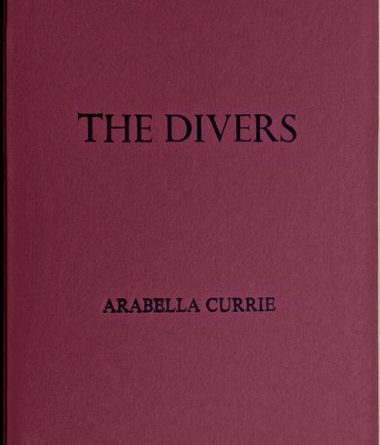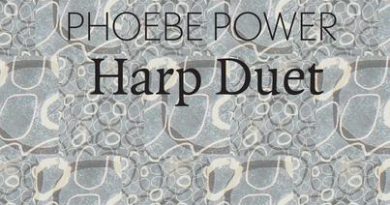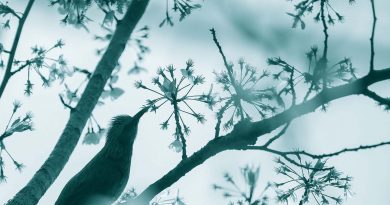The Divers by Arabella Currie
– Reviewed by Deirdre Hines –
There is a symbiosis between Arabella Currie’s The Divers as it is felt in the hand, read by the poetic line, and viewed through its illustrations, giving the ‘Divers’ of these twenty-five poems a multidimensionality that allows them to stand for something larger than their literal meaning.
The collection gets its name from ‘The Tomb of the Diver’, dedicated to Mondrian. Opened on 3rd June 1968, this grave shows a young man diving into a curling and moving stream of water. He is the “Perfect allegory/ for all time”, and like Mondrian’s radical simplification of elements of his paintings to reflect what he saw as the spiritual order underlying the visible world, the lid lifted on the diver reflects back a tower, “its lines like eyelashes”.
The black lines he looks for on a flat white stone are etched in Beth Spark’s line drawing of a tower. The temporality of the scene is unfrozen to allow the allegorical divers to chart new latitudes in the mapping of the present and in our understanding of the past. Theosophists like Mondrian believed that knowledge from the ancient world offered a path to enlightenment, and this spirit wafts the rafts that Currie sails over mythic seas.
The opening poem ‘Atlas’ builds up simile after simile:
or like four turtles
and their shouldered earth
The World Turtle is a myth of a giant turtle supporting or containing the world, and is quite a common trope. It comes from the Mandan, a Native American tribe from North Dakota. Nicodemus, Christ and Aeneas also feature, and are all central figures in their culture’s mythos, its storied foundation. One euhmerist origin for Atlas was as the King of Mauretania, an expert astronomer. Currie ends this poem with a visceral image of a fisherman
sucking sharks / through ice.
Greek and Roman mythologies inhabit this collection, which segues from poems with food as a central motif, to biographies, to translations from the Latin and Ancient Greek. Alice Oswald is a guide for Currie’s work: two of the poems are written in direct response to a line from ‘Memorial’ and to ‘A version of the Odyssey’, due to both poets’ interest in Homer. The first ‘Leaf History’ unfurls from the epigraph ‘Like leaves who could write a history of leaves’, but shades this with its own ‘enrageia’, that bright unbearable reality which the subject of the poem gathers and labels to keep him warm. It stunningly evokes the conflict between ‘logos’ (thought) and ‘mythos’ (myth):
his meticulous records
of each pattern and each fall.
In the three-part sequence ‘Dhekelia Cantonment, or The Lecture of Professor Georgiades’, Currie answers a quote from one of the refugees held in a camp on the island of Cyprus since 1998. Cyprus is thought to be the location of the home of the sorceress Circe, the island called Aeaea, where in Homer’s Odyssey, Odysseus stays for a year on his way home to Ithaca.
In Section 1, Chicory, Arabis Kennedyae, and Arabis Purpurae are Pre-Ice Age plants that still have refuge on the island, given a precise location aided by the palimpsest that covers the lines of the poem. This transparent map overlaying the page is a stunning addition to the reader’s experience of the poem.
We, here, on the 35th parallel
Poetic sequences lie partly within the topographical tradition, but this is the most innovative and unique approach to the presentation of that tradition that I have ever had the pleasure to read.
In Section 2 the map covers the lines that detail how the dead were buried and remembers the Lionheart. The lines lie beneath a pictorial representation of Turkey, which has overtones of that divided island, and also reflects the Ancient Greek surname ‘Georgiades’ in the title. Its popularity increased greatly at the time of the Crusades.
The third section’s exhausted flamingo visitors are compared with refugees:
Often, they arrive in exhausted states
and crumple at the edge of the sea.
‘Last Supper’ details Francois Mitterand’s gorging of four ortolan, while weairng the customary napkin to hide his sin from the world. The last line “He hoped God would not smell it on his breath” leads strangely and perfectly into the ekphrastic poem that faces it, ‘ The Liberation of Bergen-Belsen’.
Currie’s translation of Propertius’ ‘Epitaph for Gallus’ offers the Latin original: Currie makes a deliberate decision in this last request of a certain Gallus not to locate his death on the Etruscan hills, but on a foreign hill.
“ montibus Etruscis..” “ on a foreign hill..”
That Gallus should ask for complete concealment of his death is highly improbable, particularly in view of ancient views as to the importance of burial, but accords with many nods towards revealed concealments of truths in Currie’s work.
A fragment of a lost poem by Archilochus ends this pamphlet-length collection. Titled ‘Eclipse’, it details a total solar eclipse, but the marvel of legless dolphins revelling on the mountain refers to the homologous structures found in different species that descend from a common ancestor. This poem marks a transition from a mythos to a logos-dominated worldview, without which modern science would not have been possible. May Hurst Street Press continue to sing “ for every man in the republic” with their choice of poets.





